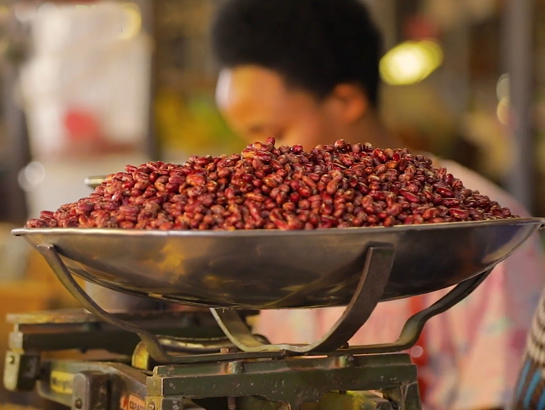“We eat these beans at home. I saw change in my child, who became healthier and weighed very well,” says Jaqueline Mushimiyimana, a farmer in Nyanza District in southern Rwanda. She stands proudly in front her bean field, hoe in hand.
Mushimiyimana and her family are one of the more than 420,000 farming households in Rwanda who cultivate iron-biofortified bean that were developed by HarvestPlus, the Rwanda Agriculture Board, and the International Center for Tropical Agriculture (CIAT), and first released in the country in 2012. In just a few years since then, iron bean cultivation has expanded rapidly and currently accounts for 20 percent of all beans grown in Rwanda; more than 1.8 million Rwandans, or about 15 percent of the total population, were estimated to be eating these nutritious beans—and the market continues to grow.
Mushimiyimana appears in a new HarvestPlus video, Iron Beans in Rwanda: A Nutrition Success Story, that shows how HarvestPlus worked with multiple Rwandan partners and CIAT to ensure that iron bean seeds were readily available to smallholder farming families, and that these families learned how to grow the beans, and they were able to sell some of the beans to earn income.
View the video below. (For best results: After starting the video, select an HD quality setting with the gear icon.)
Ultimately, the project is aimed at addressing an iron-deficiency problem that currently affects nearly 40 percent of children under five and nearly 20 percent of pregnant women. Diets deficient in iron are a major cause of anemia, as well as frequent illness, impaired mental and learning capacity, and health risks to pregnant women and their babies. These debilitating effects make it hard for people and the country as a whole to thrive.
Scientific research has shown that iron beans can address iron deficiency and its effects. One study, recently published in the Journal of Nutrition, showed that iron-deficient college-age women in Rwanda who consumed iron beans experienced not only improved iron status but aso improved ability to conduct everyday physical tasks. Other studies have shown how consumption of iron beans can improve cognitive performance and brain function.
Successfully introducing iron beans in Rwanda not only involved developing seed and input supply chains to meet farmers needs; it also required the development of an entire value chain linking farmers to consumers, so that there is sustainable demand for what the farmers produce. The video shows how HarvestPlus worked with bean aggregators, processors, distributors, and retail food companies to generate awareness and interest in foods derived from these beans.
FarmFresh, one Rwandan food company featured in the video, sells ready-to-eat precooked iron beans to busy urban consumers through supermarkets and other retail outlets. Christian Heremans, Managing Director of FarmFresh, explains in the video how FarmFresh started off in 2016 on a pilot basis with a production capacity of 15 metric tons per month of beans. They will soon ramp up to 120 metric tons per month after raising more capital investment.
Mushimiyimana also attests to the livelihoods improvements she has received from growing iron beans, thanks to the robust demand for the product. She explains how she harvests three sacks of beans and sells two, keeping one for home consumption. With the money earned, she bought more beans to plans and a cow (a major investments for many farmers), which now provides milk for the family.
HarvestPlus has also created an infographic that highlights visually what has been achieved in Rwanda:
Learn more about Rwandan iron beans in this related article.
For more information, contact Peter Goldstein: [email protected]

